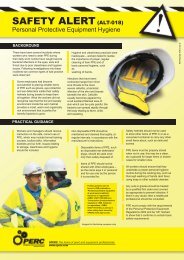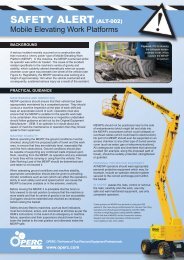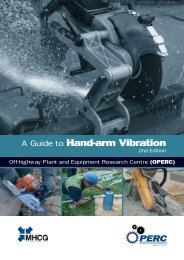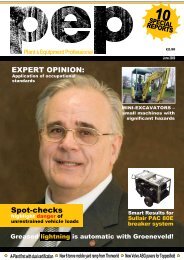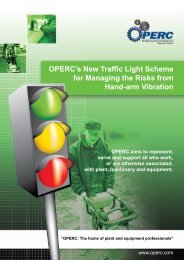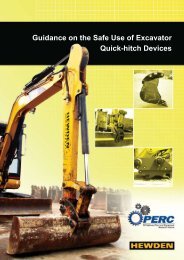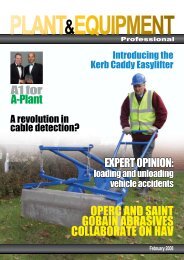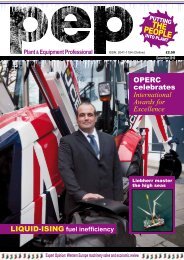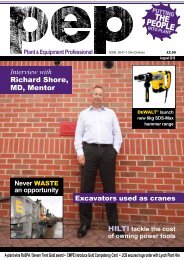Multimedia
Download A3 poster (filesize approx 4MB) - OPERC
Download A3 poster (filesize approx 4MB) - OPERC
- No tags were found...
You also want an ePaper? Increase the reach of your titles
YUMPU automatically turns print PDFs into web optimized ePapers that Google loves.
SAFETY ALERT (ALT-015)<br />
Passengers on Mobile Machinery<br />
BACKGROUND<br />
Self propelled work equipment is often<br />
incorrectly used to carry passengers. A<br />
recent incident provides an example of<br />
this, where two workers were observed<br />
riding on a forward tipping site dump<br />
truck, designed for one driver and no<br />
passengers. The driver was positioned<br />
correctly in the seat provided but the<br />
other worker was perched dangerously<br />
on the engine compartment with his<br />
feet resting on the wheel arch. The<br />
temporary road being driven upon<br />
was rough and undulating and it<br />
was noted that pedestrians were<br />
walking alongside the road without<br />
any form of vehicle/pedestrian<br />
segregation or traffic control.<br />
There was therefore a risk of<br />
serious injury or fatality, as the<br />
side passenger could have fallen<br />
and been run over, or rolled onto,<br />
by the machine.<br />
© On-track <strong>Multimedia</strong><br />
PRACTICAL GUIDANCE<br />
Regulation 25 ‘Employees carried on<br />
mobile work equipment’ of the Provision<br />
and Use of Work Equipment Regulations<br />
(PUWER, 1998) states that:<br />
Every employer shall ensure that no<br />
employee is carried on mobile work<br />
equipment unless<br />
a) it is suitable for carrying persons;<br />
b) it incorporates features for reducing<br />
to as low as is reasonably<br />
practicable risks to their safety,<br />
including risks from wheels<br />
or tracks.<br />
Self propelled work equipment should<br />
only be driven by fully trained, competent<br />
operators who have been authorised<br />
to do so and any operation should<br />
be accompanied by a suitable risk<br />
assessment. The nationally recognised<br />
qualification for competence within<br />
Britain is a Scottish/National Vocational<br />
Qualification (S/NVQ) Level II Plant<br />
Operations.<br />
Where one seat is fitted to a machine,<br />
then only one operator must be allowed<br />
to operate that machine. At all times seat<br />
restraint systems should be used and<br />
passengers should never be carried under<br />
any circumstance. Any second passenger<br />
seat fitted by the Original Equipment<br />
Manufacturer (OEM) or retro-fitted by<br />
another manufacturer, should afford the<br />
passenger (and driver) with the same level<br />
of protection with regards to seat restraint<br />
and roll over protective structures.<br />
Pedestrians must be segregated from the<br />
‘operational area’ of the machine and its<br />
transport routes; these routes should have<br />
good clear signage and appropriate traffic<br />
control measures.<br />
Site managers must be knowledgeable about<br />
safe plant operation and must take an active<br />
role in monitoring, controlling and managing<br />
all plant operations on site.<br />
When training novice operators, it is<br />
permissible to work within close proximity of<br />
the machine but a thorough risk assessment<br />
must first be completed and this should<br />
take into account (amongst other things)<br />
the type, size and configuration of machine<br />
being operated, falls from height and<br />
unexpected movement of the machine.<br />
Because such activity is deemed to be high<br />
risk, training should be conducted in a tightly<br />
controlled environment and the<br />
use of handfree mobile<br />
technology (e.g.<br />
phones or walkie<br />
talkies) should be<br />
considered if the<br />
risks identified<br />
cannot be fully<br />
controlled.<br />
Further guidance can be found in the<br />
HSE publications ‘Workplace transport<br />
safety, an employers’ guide’ (HSG 136 –<br />
ISBN 9780717661541) and ‘PUWER 1998.<br />
Provision and Use of Work Equipment<br />
Regulations 1998’ (ISBN 9780717662852),<br />
as well as in other safety alerts issued by<br />
OPERC (www.operc.com).<br />
Images for illustrative purposes only<br />
OPERC: The home of plant and equipment professionals<br />
www.operc.com
SAFETY ALERT (ALT-015)<br />
Passengers on Mobile Machinery<br />
BACKGROUND<br />
Self propelled work equipment is often<br />
incorrectly used to carry passengers. A<br />
recent incident provides an example of<br />
this, where two workers were observed<br />
riding on a forward tipping site dump<br />
truck, designed for one driver and no<br />
passengers. The driver was positioned<br />
correctly in the seat provided but the<br />
other worker was perched dangerously<br />
on the engine compartment with his<br />
feet resting on the wheel arch. The<br />
temporary road being driven upon<br />
was rough and undulating and it<br />
was noted that pedestrians were<br />
walking alongside the road without<br />
any form of vehicle/pedestrian<br />
segregation or traffic control.<br />
There was therefore a risk of<br />
serious injury or fatality, as the<br />
side passenger could have fallen<br />
and been run over, or rolled onto,<br />
by the machine.<br />
© On-track <strong>Multimedia</strong><br />
PRACTICAL GUIDANCE<br />
Regulation 25 ‘Employees carried on<br />
mobile work equipment’ of the Provision<br />
and Use of Work Equipment Regulations<br />
(PUWER, 1998) states that:<br />
Every employer shall ensure that no<br />
employee is carried on mobile work<br />
equipment unless<br />
a) it is suitable for carrying persons;<br />
b) it incorporates features for reducing<br />
to as low as is reasonably<br />
practicable risks to their safety,<br />
including risks from wheels<br />
or tracks.<br />
Self propelled work equipment should<br />
only be driven by fully trained, competent<br />
operators who have been authorised<br />
to do so and any operation should<br />
be accompanied by a suitable risk<br />
assessment. The nationally recognised<br />
qualification for competence within<br />
Britain is a Scottish/National Vocational<br />
Qualification (S/NVQ) Level II Plant<br />
Operations.<br />
Where one seat is fitted to a machine,<br />
then only one operator must be allowed<br />
to operate that machine. At all times seat<br />
restraint systems should be used and<br />
passengers should never be carried under<br />
any circumstance. Any second passenger<br />
seat fitted by the Original Equipment<br />
Manufacturer (OEM) or retro-fitted by<br />
another manufacturer, should afford the<br />
passenger (and driver) with the same level<br />
of protection with regards to seat restraint<br />
and roll over protective structures.<br />
Pedestrians must be segregated from the<br />
‘operational area’ of the machine and its<br />
transport routes; these routes should have<br />
good clear signage and appropriate traffic<br />
control measures.<br />
Site managers must be knowledgeable about<br />
safe plant operation and must take an active<br />
role in monitoring, controlling and managing<br />
all plant operations on site.<br />
When training novice operators, it is<br />
permissible to work within close proximity of<br />
the machine but a thorough risk assessment<br />
must first be completed and this should<br />
take into account (amongst other things)<br />
the type, size and configuration of machine<br />
being operated, falls from height and<br />
unexpected movement of the machine.<br />
Because such activity is deemed to be high<br />
risk, training should be conducted in a tightly<br />
controlled environment and the<br />
use of handfree mobile<br />
technology (e.g.<br />
phones or walkie<br />
talkies) should be<br />
considered if the<br />
risks identified<br />
cannot be fully<br />
controlled.<br />
Further guidance can be found in the<br />
HSE publications ‘Workplace transport<br />
safety, an employers’ guide’ (HSG 136 –<br />
ISBN 9780717661541) and ‘PUWER 1998.<br />
Provision and Use of Work Equipment<br />
Regulations 1998’ (ISBN 9780717662852),<br />
as well as in other safety alerts issued by<br />
OPERC (www.operc.com).<br />
Images for illustrative purposes only<br />
OPERC: The home of plant and equipment professionals<br />
www.operc.com



